On June 27, nearly seven years after United States and NATO troops ousted the Taliban government of Afghanistan, the Pentagon issued a comprehensive report to Congress that declared “the Taliban has regrouped and formed a resilient insurgency” and “is likely to maintain or increase its attacks in 2008.”
Last month, 40 U.S. troops were killed by the Taliban, the highest monthly toll in seven years. Major General Jeffrey Schoesser, a top U.S. commander, said attacks on his troops increased 40 percent in 2008.
On June 14 a suicide bomb at a prison in Kandahar freed hundreds of Taliban prisoners. The Taliban is using suicide bombing attacks, ambushes and roadside bombs against U.S and NATO troops. The Taliban are the descendants of the very forces the U.S once backed in a covert CIA operation to overthrow the Soviet-backed revolution in Afghanistan in the 1980s.
The 72-page “Report on Progress Toward Security and Stability in Afghanistan” said 32,000 U.S. troops are serving in Afghanistan with 14,000 serving as part of the 47,000 NATO force. Eighteen thousand are part of “training” and “counterterrorism” operations.
The report does not say that U.S. aerial bombing killed more than 6,500 civilians in 2007 and that this has strengthened support for the insurgents. Also President Karzai’s government is not meeting the basic needs of the people, with services and rebuilding roads.
The Afghan National Army (ANA), which fights alongside the U.S. troops, numbers 80,000. Each ANA combat unit is accompanied by either an embedded U.S. training team or a NATO team. As of March 2008 only one Afghan Army battalion and a headquarters unit could operate independently.
The insurgency is most intense in the Taliban strongholds of southern Afghanistan and in the east on the border with Pakistan, where a coalition of religious militant groups including al Qaeda now operate. Recently 3,500 U.S. Marines were dispatched to this area to secure the mountainous border, where insurgents cross into Afghanistan from Pakistan.
The report calls the insurgents’ safe havens in Pakistan’s tribal areas along the border “the greatest challenge to long-term security in Pakistan.” The new Pakistani government had negotiated peace agreements with these groups. But last week Pakistan had to deploy a paramilitary force to guard the city of Peshawar, when it was attacked from three sides by Taliban fighters and other religious militant groups. The Pakistani provincial government is considering arming civilian groups to defend the city.
The report said one of the greatest challenges to the security and stability of Afghanistan is its drug trade. In 2007, 93 percent of the world’s opium, an ingredient of heroin, was produced in Afghanistan. According to a UN survey, area warlords control the opium trade. The farmers receive 25 percent of the money opium generates and the remainder goes to the local officials as a tax, to the drug traffickers and to the insurgents.
It is not difficult to understand the corruption the drug- based economy breeds. Afghan police units sent out to find and eradicate poppy fields find it easier to take a bribe than a bullet.
The U.S. intelligence agencies have their own reputation for promoting drugs and the drug trade.
The United States Agency for International Development is working with some farmers to grow alternative crops. There was a 50 percent decrease in growing poppies for opium in 12 of 34 provinces in 2007. Four provinces, however, increased their yield.
The Pentagon will submit a report on Afghanistan to Congress every six months.











Comments